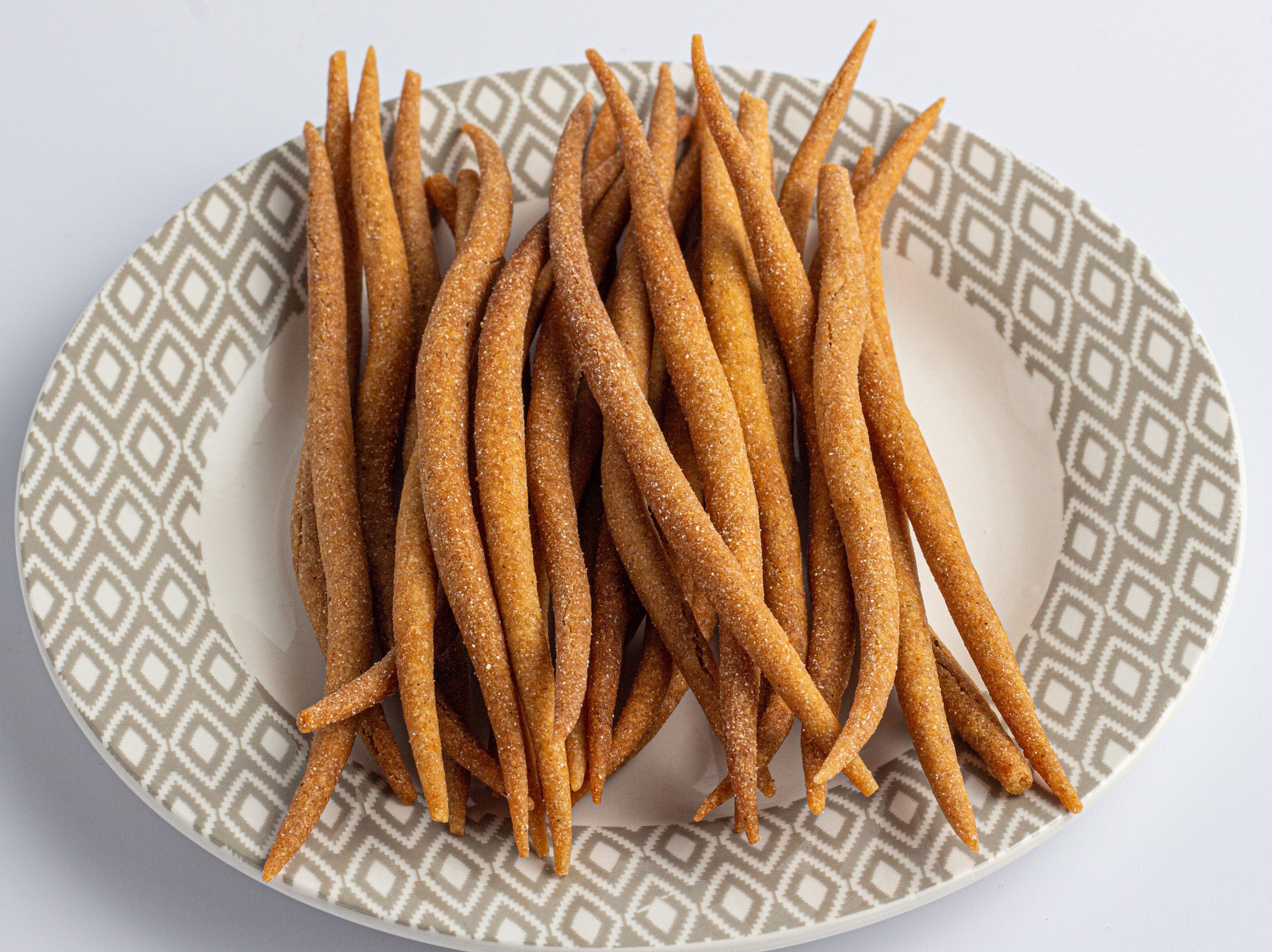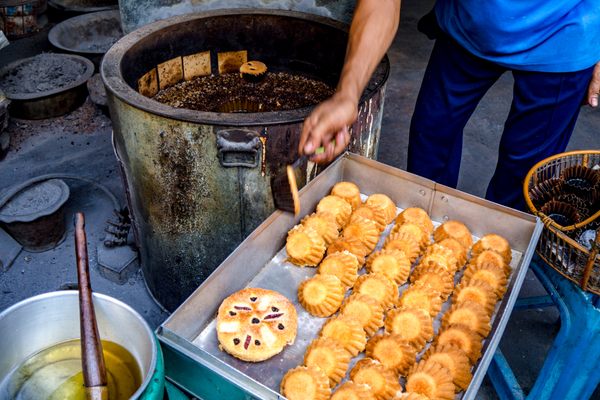

A Gastro Obscura Guide to Lagos
Meat-grilling maestros, perfectly-spiced soups, and palm-wine cocktails await in Nigeria’s most diverse city.
Lagos, on the southwestern coast of Nigeria, is the country’s most diverse city, welcoming Nigerians from different regions, Africans from East to West (especially from the neighboring Benin, Togo, and Ghana), and immigrants from further afield, like Brazil, China, Lebanon, and South Korea. The result? An astounding variety of food and drink, some of it immortalized in Yewande Komolafe’s My Everyday Lagos, published in 2023, and on the Eat.Drink.Lagos blog since 2015.
New to the city and want to explore it like a local? Get to know some restaurants, suya spots, and bukas beloved by Lagosians, both born and adopted. From a bountiful village market tucked beside a giant grocery store to a buka specializing in recipes spanning West Africa, you can enjoy seafood stews from the Niger Delta, savor creamy beans from Togo, and buy ingredients for Brazilian mingau de tapioca, all without ever leaving the city limits.

Buka Bites
The term buka is shorthand for bukateria, a contraction of bukkà, from Hausa for hut or shack, and cafeteria. It describes matriarch-led roadside restaurants where, as in cafeterias and canteens, diners grab a tray, plate, or bowl, and build meals from various serving stations. Ghana High Restaurant, popularly known as Ghana High, is a classic buka serving premium but affordable West African eats, including Nigerian jollof, a seasoned orange-red rice that’s a descendant of Senegalese thieboudienne; Togolese ewa aganyin, creamy beans with a seafood chili crisp reminiscent of XO sauce; and Ghanaian waakye, red rice with sides like spaghetti, dodo (fried plantain), and boiled eggs. Although there are Ghanaian dishes on the menu, this restaurant is named not for Ghanaian cuisine, but for its proximity to the former Ghana High Commission building.
Since the late 1980s, Ghana High has provided delicious plates of food to locals and workers on Lagos Island. They serve breakfast, lunch, and dinner for dine-in or take-out. For the latter, bring your own container or buy from a selection of colorful options at the entrance.
After a hearty meal, grab some Lagos Island snacks for later from one of several stalls on the same street that stock confections including chinchin (bite-sized fried dough pieces), kokoro (cornmeal sticks), and sisi pelebe (peanut brittle).

Past Meets Present
Nok by Alara is a restaurant named after the ancient Nok civilization (500 B.C.E. to 200 C.E). The Nok are considered one of the most advanced civilizations on the continent, with some of the earliest figurative art and evidence of the Stone-to-Iron-Age transition without an intervening Copper or Bronze Age.
Located inside the larger Alára Lagos design and fashion building, Nok by Alara combines an ambience of contemporary African art and design with culinary explorations reimagining classics stretching from Ghana to Gambia, Ethiopia to Senegal. With different menus, there’s always something new to try through the seasons, from small bites that often feature fritters, like akara and plantain beignets, to salads and mains like lamb with mafe (peanut stew) and jerk chicken with waakye.
Most memorable (albeit expensive) is their abula, a tasty, colorful quartet of favorites served in a single bowl. It consists of amala, a soft, brown dough of yam flour; obe, a spiced, bright-red tomato-and-sweet pepper stew with an assortment of braised protein, from beef to tripe to pomo (boiled cow skin); ewedu, a soup of green, viscous jute leaves; and gbegiri, a creamy, earthy orange bean stew.
Don’t skip Nok’s drinks menu, where you can get a taste of Nigerian ingenuity, whether that comes in the form of a glass of kunun aya, made with tigernuts and dates (think: horchata de chufa), or cocktails like the Palmwine Crush. The latter is a mix of passion fruit, citrus, and palm wine, a creamy local wine tapped from raphia palms, the equivalent of an Indian or Filipino toddy.

Flavors of the North
Arewa is a Hausa word for “north” and typically describes the area north of the River Niger. The Arewa kitchen celebrates the bounty of this region, rich in cereals and grains, including a wide variety of millet, fonio, sorghum, and rice. The Fulanis, a pastoral people in the north and Middle Belt regions of Nigeria, have developed a mastery of livestock on this terrain and generate an abundance of fresh dairy products (compared with the rest of the country), which include soft cheeses like wara, milk, cultured butter, and yogurt.
In Lagos, Clay Food and Drinks Limited brings you to the heart of the north with food and drinks that showcase the area’s grain and dairy resources. A classic offering is fura de nono, a combination of sweet and sour cultured milk (nono)—or sour yogurt (kindormo)—and crushed, cooked millet dough (fura). For something more tart and floral, try the zobo, a burgundy-colored drink made from hibiscus and served cold.
To sample the grains of the north, try masa. No known relation to Mexican corn masa, Nigerian masa are small, soft, chewy rice cakes cooked in pans with divots, similar to ebelskiver pans. They are great as a snack, dipped into yajin kuli, a crumbly, dry groundnut (peanut) condiment that provides a spicy, flavorful, and textural contrast to the masa’s softness. If you want something more substantial, pair the masa with miyan taushe, a pumpkin and groundnut stew, or choose from Clay Food’s variety of grilled meats. Don’t leave without extra tubs of yajin kuli.

A Taste of the South
The coastal essence of the southern Niger-Delta region is an artful blend of lake, river, and ocean influences, from fresh to smoked and dried seafood, with an unparalleled range of indigenous spices.
On the plates and in the bowls of Delta Pot, you will delight in the culinary heritage of the region, including the foods of the Isokos, Urhobos, Ijaws, Itsekiris, Igbos, Efiks, and Ibibios—the people of the Southern states.
Palm trees grow plentifully in the Niger-Delta, and several traditional dishes of the region draw their flavor from coconuts as well as banga, the creamy extract of palm nuts. Delta Pot has two standout banga dishes, in the form of banga rice, a soft, creamy risotto-like rice, and banga soup. The latter is a medley of fresh seafood like catfish, shrimps, prawns, and periwinkles seasoned with minty, slightly peppery atariko, earthy, bittersweet rigije, and herby beletete that’s served hot and bubbling in an evwere, a traditional claypot. If you want to explore more, try the gbagba kpogiri (also known as egusi pepper soup), a nutty dish that draws its flavor from creamy egusi seeds (from the melon of the same name); pepper soup spices like ehuru (calabash nutmeg), uda (grains of Selim), and uziza peppercorns; and herbs like lemongrass leaves and scent leaves.

To accompany either soup, try the “starch,” an orange-tinged, chewy dough made from tapioca starch; think of it as the savory twin of boba. To truly eat like a local, “cut” the starch into bite-sized pieces by following the three Ps: Set your thumb and index finger around the periphery of your ball of starch, pinch a small piece, then press your thumb and index finger together (or press down into the plate to sever), and pull away. Dip this morsel into your soup and enjoy.
Street Food
Nigerian village markets are a great experience. They reflect ingredients popular across different regions, as well as historic imprints and edible trails tracing back to culinary influences from afar.
The Village Market at Prince Ebeano Supermarket (one of several locations around the city) is a great place to explore a Nigerian open market in a less-sprawling setting than a larger, more traditional market. An annex, adjacent to the main store, this gem conveniently provides access to a selection of ingredients all in one place, saving multiple visits to a variety of open-air markets and other stores.

You will find produce and products from across the country. There’s ukwa (breadfruit seeds from the East); frozen fermented seeds like the umami-packed iru (seeds of locust beans); pastes of corn or millet; and indigenous spices like omilo (kernels of coco plum), igbafilo (rough-skinned plum), and country onions. You’ll also find ingredients like the granular tapioca that connects Lagos to Bahia, Brazil, used in mingau de tapioca, a pudding enjoyed all year round but especially over Easter. (It’s one of several food twins that Lagos and Bahia share, joining fritters made from black-eyed beans, like acaraje and Nigerian akara, and dishes of beans cooked in coconut milk, like feijão de coco and Nigerian frejon.)

Another unmissable aspect of open-air shopping in Lagos is suya, grilled meats from the north of Nigeria, perfectly cooked by Mai Suya, men from the north who are custodians of meat and fire knowledge. Glover Court Suya is a great place to experience this northern culinary tradition. From late afternoon to past midnight, the air is redolent with a welcoming smokiness. Sticks and skewers of meat, larger cuts, and whole poultry are spiced and seasoned before they are grilled to perfection and presented in paper wrappers. Served alongside are artfully cut red tomatoes, purple onions, and creamy-green cabbage as well as yaji, a spicy brick-red to brown condiment sprinkled all over.
Toothpicks are the cutlery of choice, though fingers work as well (avoid touching your face afterward, until you’ve washed, so the spiciness doesn’t sting). The popular beef suya consists of tiny pieces of beef that can range from tender to chewy, and are always incredibly tasty. Add some masa, if you want something more substantial. If you’re concerned about the spice levels, decline the sprinkling of yaji over the top of your meat and explore your boundaries by trying it out a bit at a time from little paper packets.
Ending with suya is just the beginning of your journey through Nigerian cuisine. There’s more to explore in Lagos: Whether that means going deeper into regional specialties, feasting on offerings from the West African subregions, or sampling other unique cuisines born from the merging of local and imported cuisines, there’s a vibrant culinary community for everyone in this bustling city by the shore.
Gastro Obscura covers the world’s most wondrous food and drink.
Sign up for our regular newsletter.






















Follow us on Twitter to get the latest on the world's hidden wonders.
Like us on Facebook to get the latest on the world's hidden wonders.
Follow us on Twitter Like us on Facebook